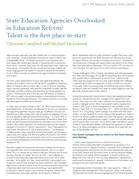This essay was written for the PIE Network 5th Annual Policy Summit, September 2011
State education agencies have been tasked with an immense productivity challenge—increasing student outcomes on fewer funds for the unforeseeable future. Are they up to the challenge?
SEAs are designed to function as compliance and regulatory agencies, and many lack the fiscal resources and technical know-how to support districts and schools to increase performance. A recent CRPE report on staffing priorities in SEAs shows that very few people are assigned to the work of “school improvement.” A huge challenge for SEAs is staffing to oversee and support district improvement across the state, and states have few guideposts for how to address this problem—research about talent management in SEAs is almost non-existent.
Fortunately, a growing body of evidence from school districts shows how educational organizations can rethink the way they manage human capital: how they hire, train, place, evaluate, and reward educators, as well as redesign central offices into problem-solving organizations. A recent CRPE study of talent management in two portfolio school districts (New York City and Washington, D.C.) shows how the entire system, not just the HR department, helps or hinders the district’s ability to attract and retain the teachers, principals, and central office administrators it needs.
While the analogy between school districts and SEAs is far from perfect, a more deliberate, strategic, and aggressive talent strategy is a critical tool for meeting the demands of today’s ambitious school reforms. This essay outlines four district strategies that can inform an SEA’s efforts to attract and deploy the kinds of people who might get traction on doing better with less.





